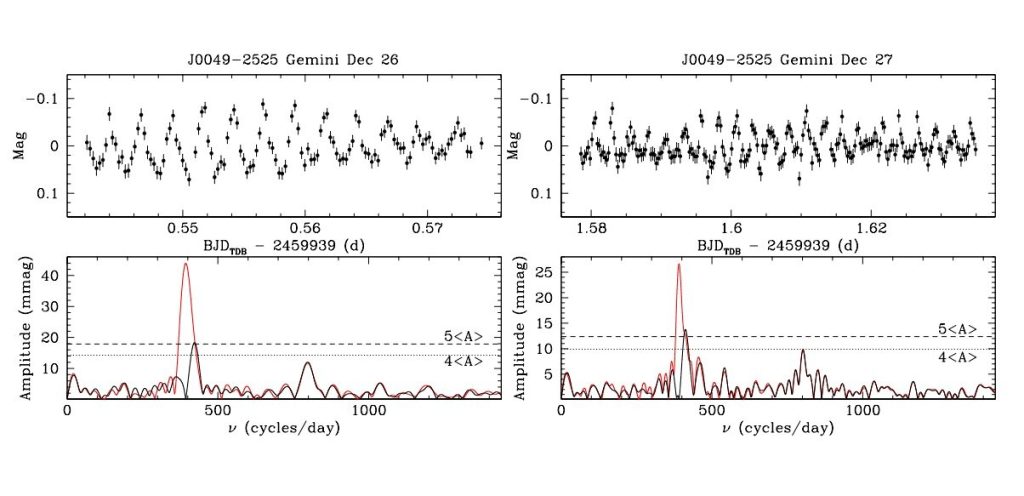Gemini time-series photometry of J0049−2525 obtained over two consecutive nights. Credit: Kilic et al, 2023
Astronomers have conducted photometric observations of a white dwarf known as J004917.14−252556.81. Results of the observational campaign detected photometric variability of this object, making J004917.14−252556.81 the most massive pulsating white dwarf known to date. The finding is reported in a paper published April 18 in Monthly Notices of the Royal Astronomical Society.
White dwarfs (WDs) are stellar cores left behind after a star has exhausted its nuclear fuel. Although their atmospheres are mainly composed of hydrogen or helium, between 25% and 50% of all known white dwarfs show traces of metals in their spectra. In general, the majority of WDs have primary spectral classification DA—they showcase hydrogen-dominated atmospheres.
Located some 325 light years away, J004917.14−252556.81 (or J0049−2525 for short) is a DA white dwarf with an effective temperature of 13,020 K and an estimated mass of approximately 1.3 solar masses. Previous studies have suggested that J0049−2525 may be a pulsating WD of the ZZ Ceti type, however, due to the lack of time-series photometric data, it was difficult to confirm this hypothesis.
That is why a team of astronomers led by Mukremin Kilic of the University of Oklahoma in Norman, Oklahoma, decided to conduct time-series photometric observations of J0049−2525. For this purpose, they employed the Apache Point Observatory (APO) in New Mexico and the Gemini South telescope in Chile.
The observations detected about 30 millimag variations in J0049−2525 at two different frequencies over four different nights. The finding makes J0049−2525 the most massive pulsating white dwarf known to date—significantly more massive than the previous record holders BPM 37093 and GD 518.
The study also found that J0049−2525 does not display any of the signatures of binary mergers and showcases no evidence of magnetism, rapid rotation, or large tangential velocity. Its spectrum was found to be of a typical DA white dwarf. These findings indicate that J0049−2525 likely formed through single star evolution and is likely to have an oxygen-neon (ONe) core.
According to the authors of the paper, evolutionary models predict that the interior of J0049−2525 is crystallized. However, it is difficult to confirm this prediction with currently available data, so the astronomers propose further photometric investigations of this white dwarf.
“Because periods and their spacings vary with mass, effective temperature, hydrogen envelope mass, and the crystallized mass fraction, and because J0049−2525 displays only two significant modes in our APO and Gemini data, it is impossible to find a unique seismic solution…. A significant number of additional pulsation modes would need to be detected to overcome the degeneracies in the asteroseismic fits. We encourage extensive follow-up time-series photometry campaigns on this unique target,” the researchers concluded.
More information: Mukremin Kilic et al, WD J004917.14−252556.81: the most massive pulsating white dwarf, Monthly Notices of the Royal Astronomical Society (2023). DOI: 10.1093/mnras/stad1113. on arXiv: arxiv.org/abs/2304.10330
© 2023 Science X Network
Citation: Study finds J0049−2525 is the most massive pulsating white dwarf (2023, May 3) retrieved 16 May 2023 from https://phys.org/news/2023-05-j00492525-massive-pulsating-white-dwarf.html
This document is subject to copyright. Apart from any fair dealing for the purpose of private study or research, no part may be reproduced without the written permission. The content is provided for information purposes only.

